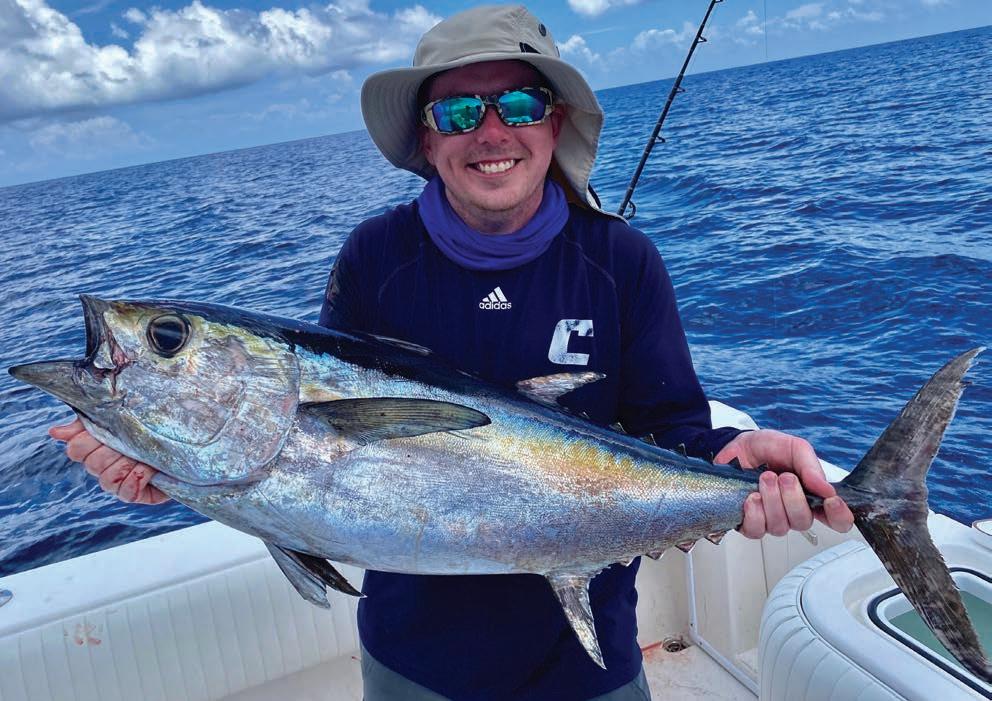
7 minute read
OUTDOORS
THE SUN
Reel Time On The Road: Montana’s Big Hole and Beaverhead Rivers
AUGUST 12, 2020
Reel Time
RUSTY CHINNIS
When Robert Redford introduced fly fishing to popular American culture in the 1992 movie A River Runs Through It, he also introduced them to the storied trout streams and rivers of Montana. Although I had been a fly fisher for some time this, like so many other anglers, was my introduction to this beautiful part of the world. Over the years I have had the pleasure to fish many of the iconic trout rivers and streams in Montana, Idaho and Wyoming. While I was always enthralled with the scenery that a float trip opened up to anglers it was a trip to Oregon last year that expanded my horizons. My wife Chris and I were on the Deschutes River when we found out that you couldn’t fish from the boat there. The fishing consisted of stops to wade for trout and steelhead. What that trip taught me was to take breaks from fishing during a float to sit back and really appreciate the scenery.
When I had the opportunity to take a trip to Montana and experience some famous rivers I had never fished, I signed on. My friend Captain Rick Grassett has been leading trips to Montana every year for the past two decades and this year I joined him on the trip. This was an opportunity to fish the Beaverhead and the Big Hole Riv

ers near Dillon, Montana. The group was hosted by Dave King of King Outfitters and stayed at the Hansen Ranch, a working cattle ranch, an hour southwest of Dillon. Over five days we fish various sections of both rivers as well as a day on a private section of the Beaverhead that included a spring creek. Not only did we have wonderful fishing but we were also treated to some spectacular scenery and wildlife only available during a float. I did my share of catching wild rainbow, brown and cutthroat trout but also took breaks to just sit back and take in the scenery and the moose, wild turkeys and mule deer that were visiting the river to drink.
We fished dry flies with nymph droppers which gave us a chance at explosive surface strikes from aggressive trout but also allowed us to explore the deeper sections of the river where trout feed on various stages of insects that develop there. My largest trout, a 22” brown, was taken on the private section of the Beaverhead and attacked my hopper imitation with a vengeance. We were alternately guided by King and Dan Allen on our drifts and they provided excellent instruction in reading the river and working the fly line to deal with the various seams and back eddies, to create a natural drift for our flies.
The days of fishing were the highlight of the trip followed closely by the appetizers and meals we enjoyed back at the lodge courtesy of Annie Waltz Kubicka. Kubicka prepared food that

RUSTY CHINNIS | SUN Dave King of King Outfitters prepares to release the author’s 22” brown trout after a quick photo.
combined eye and palate appeal, a consistent topic of conversation and praise from the group.
If you haven’t experienced the fishing and scenery along one of America’s wild rivers, I highly recommend it. Grassett runs yearly trips to Montana.











For more information and to experience this fantastic fishery contact him at 941-350-9790. Contact King Outfitters at (406) 596-0209 or visit his Facebook page at King Outfitters. Next week Yellowstone and the Madison River Valley.

















CAPTAIN DAVE WHITE | SUBMITTED Joe Baugham, of Thomasville, Ga., hoists a blackfin tuna in the 25-30 lb. range. Caught on a live sardine with Captain David White of Anna Maria Charters.

Yellowtail plentiful offshore
CAPTAIN DAVE WHITE
Offshore conditions have been awesome the last week or so. The temps are high, but it’s worth braving the heat for the bounty you’ll collect. Lately, I’ve been getting the limit of big yellowtail snapper just about every trip. These guys seem to love the heat. But you have to reel them in fast to avoid them getting eaten by the ever present barBIRD TIPS
During bird nesting season, March through August, please follow these tips: • Never touch a shorebird chick, even if it’s wandering outside a staked nesting area. • Teach kids not to chase birds – bird parents may abandon nests if they’re disturbed. • Don’t feed birds – it encourages them to fly at people aggressively and is not good for their health. • If birds are screeching and flying at you, you’re too close. • Avoid posted bird nesting areas and use designated walkways to the beach. • Keep pets away from bird nesting areas. • Keep the beach clean; food scraps attract predators such as raccoons and crows to the beach, and litter can entangle birds and other wildlife. racuda. It seems their only purpose is to steal your dinner. Much like goliath grouper. We’ve also been getting nice mangrove snapper, red grouper, and the occasional blackfin tuna.
Reading the bottom while running from spot to spot has been extremely productive. Marking stacks of bait that are being pinned to the bottom by little tunny and tuna are • If you see people disturbing nesting birds, call the Florida Fish and Wildlife Conservation Commission’s Wildlife Alert hotline at 888-404-FWCC (3922). TURTLE TIPS
During sea turtle season, May 1 – Oct. 31, please follow these tips: • Turn off lights visible from the beach and close blinds from sundown to sunrise; lights confuse nesting sea turtles and may cause them to go back to sea and drop their eggs in the water, where they won’t hatch. Light can also attract hatchlings away from the water. • Don’t use flashlights, lanterns or camera flashes on the beach at night. • Remove all objects from the sand from sundown to sunrise; they can deter sea turtles from nesting and disorient hatchlings. • Fill in the holes you dig in the how we’re finding them. You may not get a lot, but when we get them, they’re generally pretty big!
Inshore, Captain Johnny Mattay has been focused on the mangrove snapper. They seem to be getting bigger! Easy pickings for fish tacos. Also inshore, we’re finding black drum, snook and permit. Fishing is great right now and it’s making us
look good. Tight lines. sand before leaving the beach; they can trap nesting and hatching sea turtles, which cannot live long out of the water. • Don’t use wish lanterns or fireworks; they litter the beach and Gulf. • Do not trim trees and plants that shield the beach from lights. • Never touch a sea turtle; it’s the law. If you see people disturbing turtles, call the Florida Fish and Wildlife Conservation Commission’s Wildlife Alert hotline at 888-404- FWCC (3922). NESTING NEWS
Turtle nests laid: 348, up from 332 last week (Record: 544 in 2019)
False crawls: 448
Nests hatched: 107
Hatchlings hatched: 5,866 (Record: 35,788 in 2018)
Nest disorientations: 0




